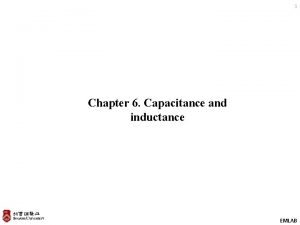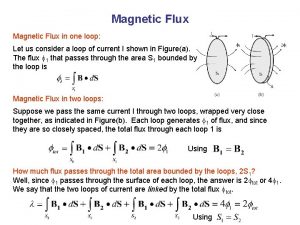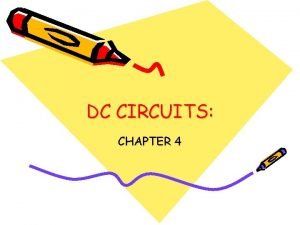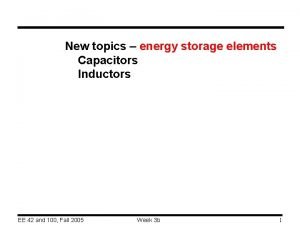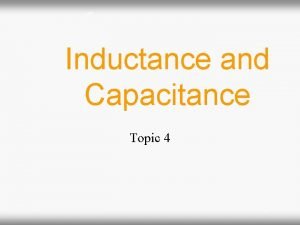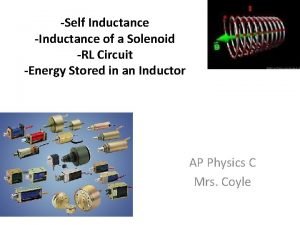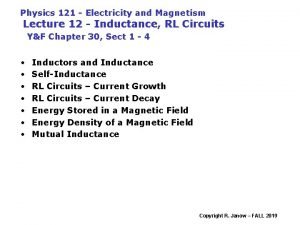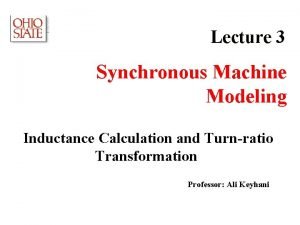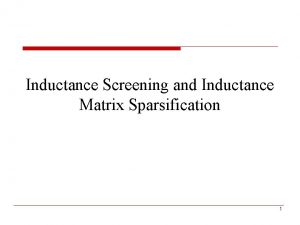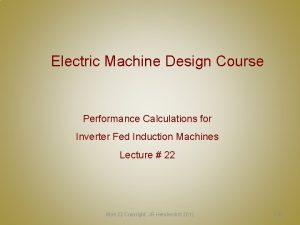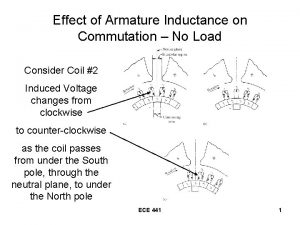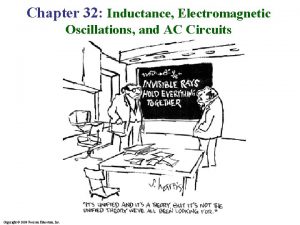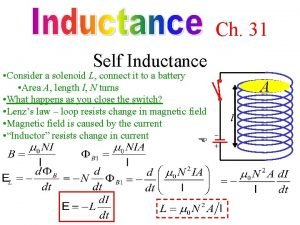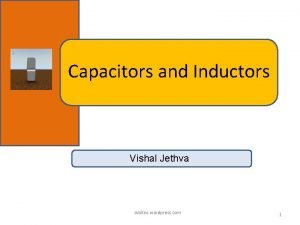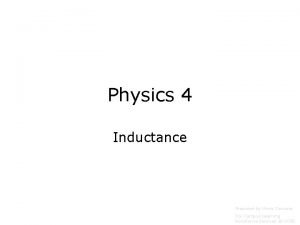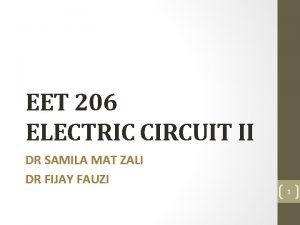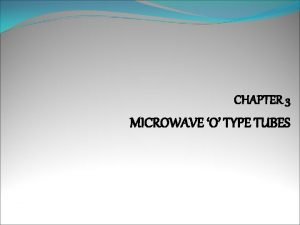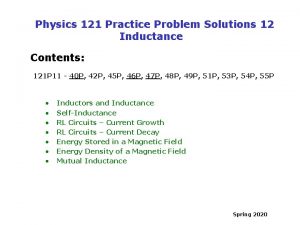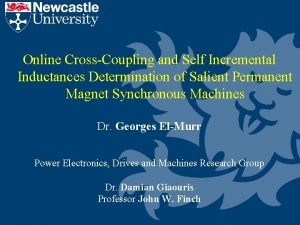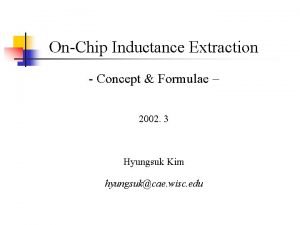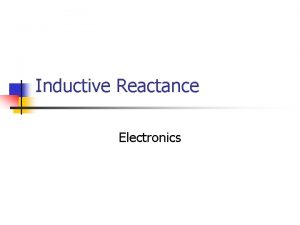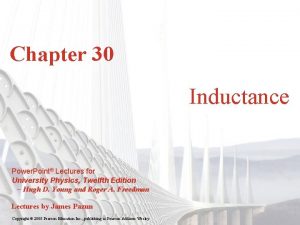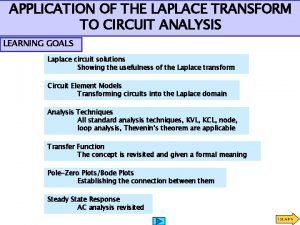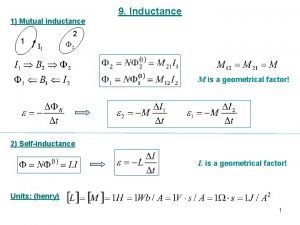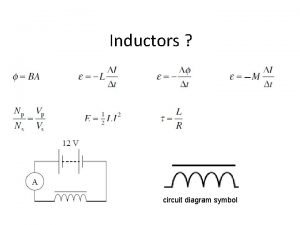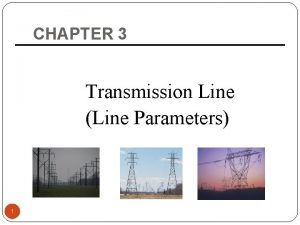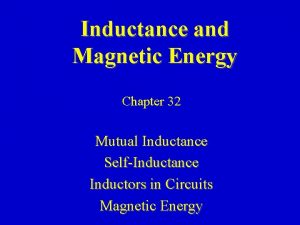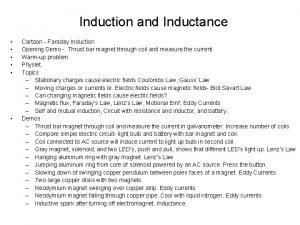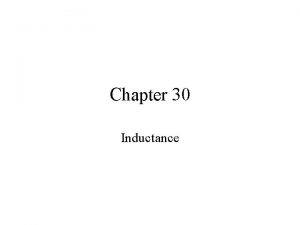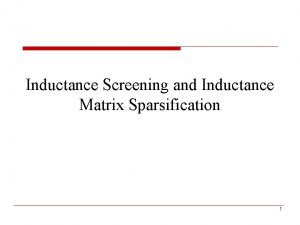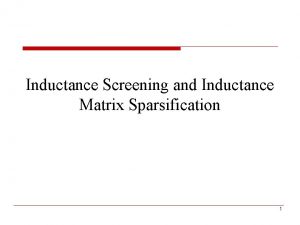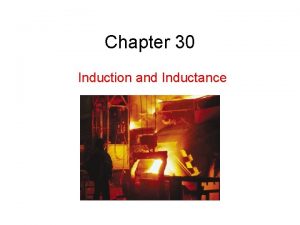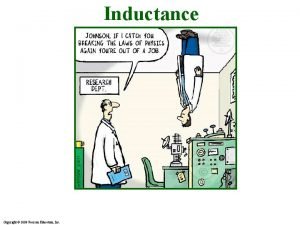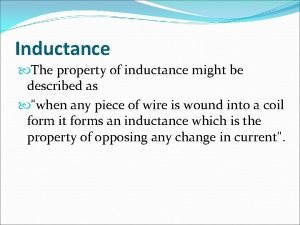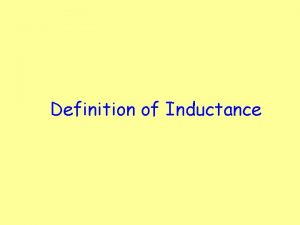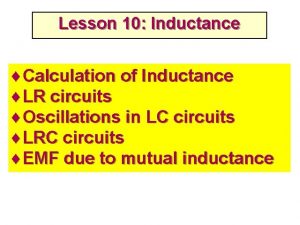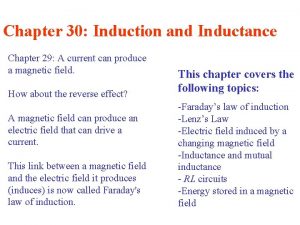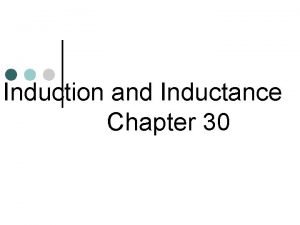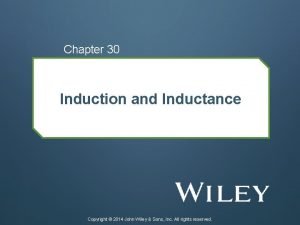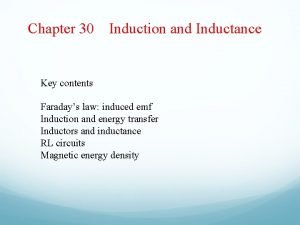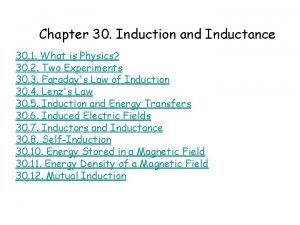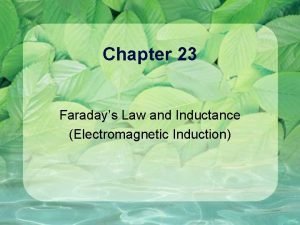Chapter 30 Induction and Inductance 30 2 First






























- Slides: 30

Chapter 30 Induction and Inductance

30. 2: First Experiment: 1. A current appears only if there is relative motion between the loop and the magnet (one must move relative to the other); the current disappears when the relative motion between them ceases. 2. Faster motion produces a greater current. 3. If moving the magnet’s north pole toward the loop causes, say, clockwise current, then moving the north pole away causes counterclockwise current. Moving the south pole toward or away from the loop also causes currents, but in the reversed directions. The current thus produced in the loop is called induced current.

30. 2: Second Experiment: q. Fig. 30 -2, with the two conducting loops close to each other but not touching. If we close switch S, to turn on a current in the right-hand loop, the meter suddenly and briefly registers a current—an induced current—in the left-hand loop. q. If we then open the switch, another sudden and brief induced current appears in the left hand loop, but in the opposite direction. q. We get an induced current (and thus an induced emf) only when the current in the right-hand loop is changing (either turning on or turning off) and not when it is constant (even if it is large).

30. 3: Faraday’s Law of Induction

30. 3: Faraday’s Law of Induction: Suppose a loop enclosing an area A is placed in a magnetic field B. Then the magnetic flux through the loop is If the loop lies in a plane and the magnetic field is perpendicular to the plane of the loop, and I fthe magnetic field is constant, then The SI unit for magnetic flux is the tesla–square meter, which is called the weber (abbreviated Wb):

Example, Induced emf in a coil due to a solenoid:



Example, Induced emf and current due to a changing uniform B field:

Example, Induced emf and current due to a changing nonuniform B field:


30. 5: Induction and Energy Transfers: Eddy Currents

30. 6: Induced Electric Field:

30. 6: Induced Electric Fields, Reformulation of Faraday’s Law: Consider a particle of charge q 0 moving around the circular path. The work W done on it in one revolution by the induced electric field is W =Eq 0, where E is the induced emf. From another point of view, the work is Here where q 0 E is the magnitude of the force acting on the test charge and 2 pr is the distance over which that force acts. In general,

30. 6: Induced Electric Fields, A New Look at Electric Potential: When a changing magnetic flux is present, the integral is not zero but is d. FB/dt. Thus, assigning electric potential to an induced electric field leads us to conclude that electric potential has no meaning for electric fields associated with induction.

Example, Induced electric field from changing magnetic field:

Example, Induced electric field from changing magnetic field, cont. :

30. 7: Inductors and Inductance: An inductor (symbol ) can be used to produce a desired magnetic field. If we establish a current i in the windings (turns) of the solenoid which can be treated as our inductor, the current produces a magnetic flux FB through the central region of the inductor. The inductance of the inductor is then The SI unit of inductance is the tesla– square meter per ampere (T m 2/A). We call this the henry (H), after American physicist Joseph Henry,

30. 7: Inductance of a Solenoid: Consider a long solenoid of cross-sectional area A, with number of turns N, and of length l. The flux is Here n is the number of turns per unit length. The magnitude of B is given by: Therefore, The inductance per unit length near the center is therefore: Here,

30. 8: Self-Induction:

30. 9: RL Circuits: If we suddenly remove the emf from this same circuit, the charge does not immediately fall to zero but approaches zero in an exponential fashion:

30. 9: RL Circuits:

Example, RL circuit, immediately after switching and after a long time:

Example, RL circuit, during a transition:

30. 10: Energy Stored in a Magnetic Field: This is the rate at which magnetic potential energy UB is stored in the magnetic field. This represents the total energy stored by an inductor L carrying a current i.

Example, Energy stored in a magnetic field:

30. 11: Energy Density of a Magnetic Field: Consider a length l near the middle of a long solenoid of cross-sectional area A carrying current i; the volume associated with this length is Al. The energy UB stored by the length l of the solenoid must lie entirely within this volume because the magnetic field outside such a solenoid is approximately zero. Also, the stored energy must be uniformly distributed within the solenoid because the magnetic field is (approximately) uniform everywhere inside. Thus, the energy stored per unit volume of the field is

30. 12: Mutual Induction: The mutual inductance M 21 of coil 2 with respect to coil 1 is defined as The right side of this equation is, according to Faraday’s law, just the magnitude of the emf E 2 appearing in coil 2 due to the changing current in coil 1. Similarly,

Example, Mutual Inductance Between Two Parallel Coils:

Example, Mutual Inductance Between Two Parallel Coils, cont. :
 Inductance capacitance formula
Inductance capacitance formula Magnetic flux and inductance
Magnetic flux and inductance Capacitor and inductor in dc circuit
Capacitor and inductor in dc circuit Capacitance and inductance formula
Capacitance and inductance formula Inductance energy
Inductance energy Magnetizing inductance
Magnetizing inductance Self inductance of a coaxial cable
Self inductance of a coaxial cable Self inductance of solenoid
Self inductance of solenoid Inductor emf formula
Inductor emf formula Magnetizing inductance
Magnetizing inductance Matrix sparsification
Matrix sparsification Imflux course
Imflux course Electronics circuit 2
Electronics circuit 2 What is interpoles in dc machine
What is interpoles in dc machine Wheatstone bridge thevenin
Wheatstone bridge thevenin Inductance units
Inductance units Self inductance
Self inductance Finding equivalent inductance
Finding equivalent inductance Rl circuit current
Rl circuit current Bridged t network transfer function
Bridged t network transfer function Transformer dot convention
Transformer dot convention Difference between o type and m type tubes
Difference between o type and m type tubes Inductance practice problems
Inductance practice problems Incremental inductance
Incremental inductance Self inductance formula
Self inductance formula Si unit of inductive reactance
Si unit of inductive reactance Inductance
Inductance Laplace transform for circuit analysis
Laplace transform for circuit analysis Inductance factor
Inductance factor Inductor diagram symbols
Inductor diagram symbols Gmr of 7 strand conductor
Gmr of 7 strand conductor
